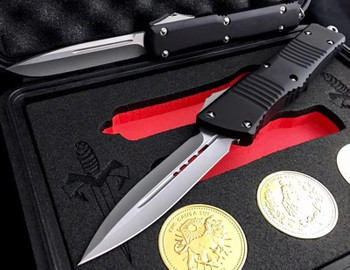Learning the Difference Between Knives and Daggers
Posted by EKnives on Mar 21st 2024
If the image you conjure up of a knife and a dagger is the same, we need to chat. Yes, they have a lot of similarities, but they aren’t the same. Let’s talk about the differences between these two sharp tools.
Definitions
Knives are tools with sharp blades that you can use to help with several different things, such as:
- Meal preparation
- Hunting
- Opening boxes
- Cutting rope
Daggers are very similar to knives, but they slightly differ in appearance and list of uses. People primarily use daggers as tools for combat, to use the dagger as a weapon.
Design Differences
In their design, knives and daggers differ in five key areas.
1. The Blade
On a dagger, the blade is double-sided. Since their purpose is to sink straight into flesh, early dagger designers created them to be able to thrust easily into the brandisher's target. Knives, however, have one sharp side of the blade and one smooth side. This design allows you to use the unsharpened side for leverage when cutting with the knife. Think about chopping with a chef's knife. Sometimes, you need to put your hand on the bolster to give it a little extra oomph. Occasionally, hunting and fishing knives will have a serrated section on the knife's spine (like the Toor Knives Field 1.0 Blood Red Wood Fixed Blade Knives for sale) instead of being completely unsharpened. But as a general rule, a dagger's blade is two-sided, and a knife's blade is one-sided.
2. Weight
Daggers typically weigh less than knives do. This lightweight feature makes daggers easier to conceal and wave around threateningly. On the other hand, the weight of knives can vary greatly depending on the type of knife. From small knives (like the Benchmade Partial Auto Immunity Axis Knife 2950-BK) to big knives (like the RMJ Tactical knives for sale), there's quite a range for knife weight.
3. Handle
Dagger designers made the handles with the intention of quickly passing the tool between hands (again, think fight). The knife handle is more to encourage grip and keep it firmly in your hand.
4. Symmetry
Because the blades are double-sided, the original daggers were symmetrical. Knives, however, are only occasionally symmetrical down their spine. Even then, some have handles that are designed for comfort and don't have any symmetry. More modern versions of the dagger, however, are not always symmetrical. OTF daggers (like this Microtech Ultratech OTF Automatic Knife Red Dagger Black 122-1RD) will have their spring drive and button mechanism that breaks symmetry there. Fixed blade daggers (like the Spyderco Nightstick Fixed Blade Knife Black G10 4.14" Dagger Satin FB47GP) have the classic, symmetrical look.
5. Safety
Knife designers always have safety in mind. The intention with a knife is to get a job done and not cause anyone harm. Daggers, however, aren't nearly as safe. With their double-edged blade, using them can be more precarious.
The History of Knives and Daggers
Which came first, the knife or the dagger? Unlike chickens and eggs, we do know the answer to this riddle. Knives were designed first out of stone hundreds of thousands of years ago. These early knives were utilized as tools to help with food preparation and harvesting, just like we see knives used today. Throughout the years, their uses expanded to include survival and construction. These ancient people eventually used knives for combat as well.
Civilizations eventually discovered metalwork, and they designed knives using steel and iron.
Our predecessors only invented daggers later, with early prototypes made out of bone. Warriors and soldiers used them.
One constant throughout history has been the design of the dagger. Little has changed from its early inception. And throughout history, it has always remained double-sided.
Daggers do have some variation in their length. Some daggers have long and slender blades, like the Italian Cinquedea. Other daggers, like the Scottish dirk, have shorter double-sided blades.
Their Uses Today
We know of some famous deaths by dagger (Julius Caesar comes to mind). But today, daggers are not as widely used as a tool for self-defense as guns are. Modern uses of daggers are typical as collector's items in knife collections, or some militaries still outfit their soldiers with them. The dagger pattern is on the bayonet in many military gun designs.
Knives are used by people around the world every day. From cutting bread with a large serrated knife to spreading butter with a small, rather dull knife, people use knives much more widely than daggers.
You should now be able to spot a tool out in the wild and determine whether it is a knife or a dagger. (Just don’t find out by testing both sides of the blade on your finger!)
Infographic
If you think a knife and a dagger are the same, think again. Although they share similarities, they have distinct differences. Explore the distinctions between these two sharp tools in this infographic.


